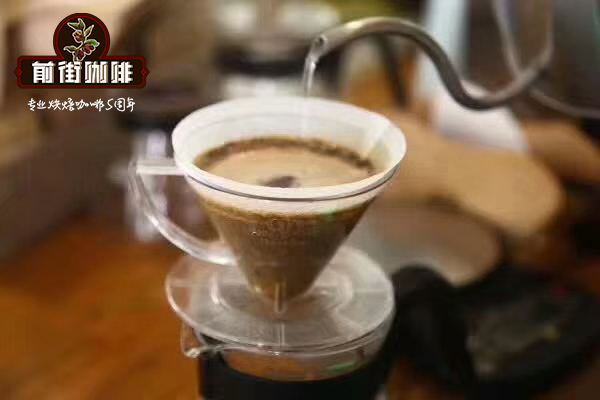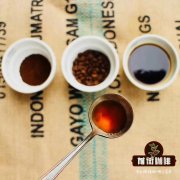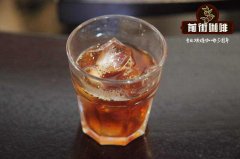Money doesn't always buy bourbon.

Professional coffee knowledge exchange more coffee bean information please follow the coffee workshop (Wechat official account cafe_style)
The coffee we usually drink, whether from the Arabica species (Coffea arabica), Robusta (Coffea robusta), or the rarer Liberia (Coffea liberica), is botanically a species of Rubiaceae and Coffee. There are many varieties in the genus Coffee, of which more than 100 have been recorded, but so far, only two of them, Arabica and Robusta, are noteworthy. This is because about 3% of the world's coffee comes from Arabica and 1 from Robsta, which together accounts for about 98% of the total, and nearly 2% of the remaining coffee is Liberian coffee.
For those who pursue high-quality coffee, both Arabica and Robusta will probably focus on the former, for a simple reason: Arabica coffee is not guaranteed to have a good flavor, but high-quality coffee, including all fine coffee, is all in the category of Arabica, and Robusta can only be listed as commercial beans.
When it comes to Arabica, it is actually like a big family, and there are many different members of the family, among which the members who have the greatest influence on the coffee world are Bourbon and Typica. The reason is that coffee was once an exclusive Arab commodity, and in order to maintain its monopoly, Arabs would never allow germinating seeds to leave their place of origin; but in the 17th century, seeds were eventually smuggled into the new world, where they spread their branches and leaves and produced countless offspring, the stolen seeds being bourbon and Tibica. In the process of reproduction, many new varieties are produced due to various factors, such as natural mutation (natural mutation), intraspecific mating, artificial breeding and so on, such as Kaddura, Catuai, Pacas, Maragogype, Pacamara, SL28, SL34 and other long lists. It can be said that the vast majority of Arabica coffee we drink today are descendants of stolen bourbon and Tibica.
Bourbon coffee got its name because it was first widely cultivated in the New World, when it was called Bourbon Island, which is now Reunion Island.
The legendary protagonist in this article, sharp bourbon, is a natural mutant of bourbon coffee on the island.
/ /
Bourbon Pointu has two other names, Laurina and Leroy, but neither is as loud as the first name. The reason why it is called sharp bourbon is that the bean shape is long and narrow and both ends are pointed, while the native species bourbon (some call it round bourbon) has a shorter bean body and a slightly oval outline. If you look at (figure 1) and (figure 2), you should be able to tell the difference in appearance between sharp bourbon and native species bourbon. However, the biggest difference between the two is not in shape, but in flavor and caffeine content. If you use simple words to describe sharp bourbon, it means "good flavor, low caffeine content".
▲ cusp bourbon
▲ native species bourbon (circular bourbon)
With regard to the flavor of sharp bourbon, I will finally talk about the caffeine content of sharp bourbon. According to statistics, the caffeine content of ordinary coffee beans, Arabica, Robbsta, and sharp bourbon is 0.9%, 1.2%, 1.6%, 2.4% and 0.6%, respectively, which is much lower than that of Arabica coffee and much lower than Robusta. Although it does not meet the American standard of decaffeinated coffee (Decaffeinated coffee), it is already a boon for many people who can't stand too much caffeine but love it.
Because of its good flavor and low caffeine content (which does not affect sleep), sharp bourbon was loved as early as the 18th century, and many celebrities, such as King Louis XV of France, and Balzac, the great writer, were fans of it. Balzac called her a delicious coffee with a thousand cups of sleep.
During the two hundred years of the 19th century, the sharp bourbon was widely planted on the island of bourbon, and its annual production reached a peak of 4,000 metric tons in 1800, but then a series of disasters such as hurricanes, fire ants and leaf rust followed, so that the planting decreased. Finally, in 1942, the last batch of sharp bourbon was shipped back to France, leaving only a pitiful 200 kilograms, and since then, sharp bourbon disappeared without a trace. Even the official documents are no longer mentioned. After the 1950s, coffee was no longer grown on the island of Reunion, and agriculture on the island turned completely to other crops such as sugar cane. Coffee was no longer associated with the island of Reunion, while sharp bourbon was recognized by the coffee industry as "extinct."
/ /
The reappearance of sharp bourbon is the legend to be talked about in this article, which can be attributed to a Japanese coffee expert, Yoshihiro Kawashima (Jose Yoshiaki Kawashima).
Mr. Kawashima was born in 1956. Because his father runs a coffee roasting business, it can be said that he grew up in a coffee environment. In 1975, after graduating from high school, he was sent by his father to El Salvador, where he had business contacts, to study in the economics department of the university, but Kawashima was actually interested in coffee rather than economics, so he spent a lot of time studying coffee. He even gave up his studies in economics in order to go to the "National Coffee Institute" to study coffee. His father, who learned of this, stopped financial support from Kawashima in a rage. But Kawashima did not change his mind, traded his work as a translator for living expenses, worked part-time and continued to study coffee until 1981, when civil war broke out in El Salvador when he was 25 years old.
During his stay in El Salvador, Kawashima heard from experts at the National Coffee Institute that sharp bourbon was famous. Although the experts thought that sharp bourbon was extinct, he cherished the dream that "maybe we can still find it."
After returning to China, he joined the UCC Coffee Company, worked in the agricultural research department, and served as the supervisor of UCC's overseas planting sites, including Jamaica, Hawaii, Sumatra, etc. In 1999, when I went on a business trip to East Africa, I visited the neighboring island of Reunion and asked local people to accompany me in the search for a possible remnant of the sharp bourbon. He found that many of the young people on the island did not even know that Reunion used to be an important coffee producing area in history, and that this is where the famous "bourbon" variety originated. According to Kawashima's recollection, a young man once took him to the mall and thought he was looking for coffee beans on the shelf.
A short day of search, but did not get any results, Kawashima returned to Japan disappointed, thinking that his dream was finally dashed. But two years later, a local veterinarian who had accompanied him in his search for sharp bourbon found 30 coffee trees in the field and immediately informed Kawashima. Kawashima rushed to Reunion immediately and confirmed that the 30 coffee trees were correct.
Finally, in cooperation with UCC and French officials, after five years of restoration, a preliminary result was achieved in 2007: 700kg of raw coffee beans. UCC was shipped back to Japan in 240kg. After roasting ripe beans, 2000 units in 100g were sold at a "sky-high price" of 7360 yen per unit, which was snapped up as soon as it was listed. It rose to 8750 yuan per unit the next year, and coffee shops sold coffee enthusiasts at a high price of 5250 yen per cup of coffee. Today, it is still the noblest coffee today.
This is the end of the legend of sharp bourbon. Finally, let's talk about its flavor. Due to the unique natural conditions of the producing area, the soil, sunshine, Rain Water and air temperature are closely related, so that the sharp bourbon has a "bright sour taste, blueberry, vanilla smell, velvety smooth" flavor description, obvious flower and fruit aromas. the aftereffect is a mellow blend of citrus and cream. She is also nicknamed "Presidential Coffee" because the Elysee Palace in France regularly buys it for former French President Jacques Chirac, but her output is so low that even the president has to limit the supply.
It is precisely because the sharp bourbon has a special experience, has an almost perfect flavor, and is sought after by many well-known figures. Any coffee player would like to have a chance to appreciate it.
Precious breeds such as Blue Mountain, Kona, Panamanian Rose Summer and Musk Cat can be tasted as long as the silver is in place, but some coffee can not be drunk with money, and she is destined to be a legend.
Related recommendation: introduction of the difference between Brazilian yellow bourbon coffee beans by hand and red bourbon
Important Notice :
前街咖啡 FrontStreet Coffee has moved to new addredd:
FrontStreet Coffee Address: 315,Donghua East Road,GuangZhou
Tel:020 38364473
- Prev

The story of Jamaican Blue Mountain Coffee and the introduction to the history of Jamaican coffee.
Professional coffee knowledge exchange more coffee bean information please follow the coffee workshop (Wechat official account cafe_style) the story of Jamaica Blue Mountain Coffee Blue Mountain Coffee is the best coffee in the world. The Blue Mountains are located in the east of Jamaica, because the mountain is surrounded by the Caribbean Sea. Whenever the weather is clear, the sun shines directly on the blue sea, reflecting from the peaks.
- Next

Apart from tequila, how does Mexican coffee taste? what coffee beans do you recommend in Mexico?
Professional coffee knowledge exchange more information about coffee beans Please pay attention to the coffee workshop (Wechat official account cafe_style) Coffee produced in Mexico has a long history and is now one of the important coffee producing countries in the world. The coffee produced in Mexico is naturally called Mexican coffee. About 5 ℃ of the total area of Mexico are plateaus and mountains, with an annual average temperature of 2527 ppm.
Related
- How did the Salvadoran coffee industry develop in Central America?
- What exactly does the golden cup extraction of coffee mean?
- The Origin of Coffee flower
- [2023 Starbucks World Earth Day] there are more meaningful things besides free Starbucks coffee!
- What kind of coffee is there in Spain? 9 Flavors of Spanish Coffee
- Aromatic African coffee| Kenya's coffee culture and historical production area
- Liberica Coffee Bean knowledge: the characteristics of Liberian Coffee beans of the three original species of Coffee beans
- The origin and formula of Spanish latte introduces the taste characteristics of Bombon coffee in Valencia, Spain.
- How to adjust the solution of over-extracted coffee
- What is the tasting period of coffee beans? What is the period of coffee and beans? How should coffee wake up and raise beans?

